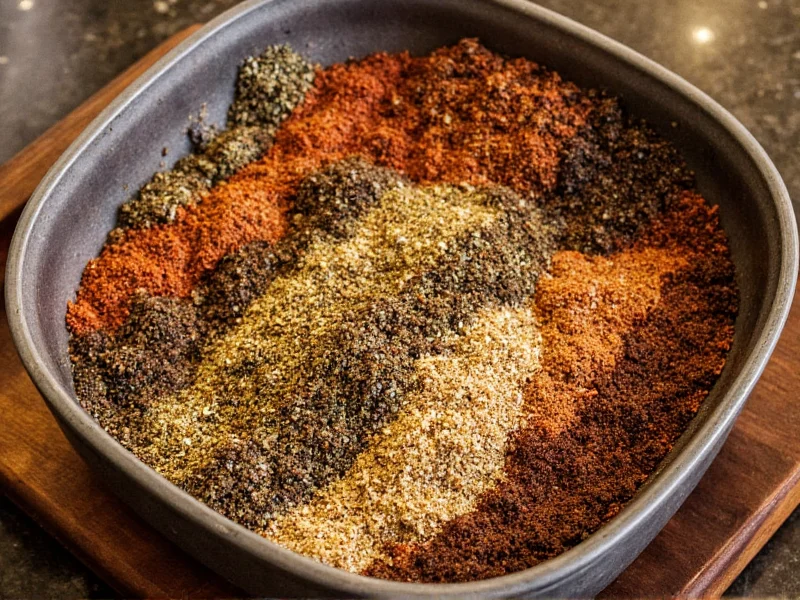Sazón, which translates to “seasoning” in Spanish, is a beloved staple in Latin American and Caribbean kitchens. This vibrant seasoning blend adds both color and complex flavor to rice, meats, stews, and traditional dishes across many cultures. Understanding exactly what's in sazón seasoning helps home cooks make informed choices about what they're adding to their meals.
Core Ingredients in Traditional Sazón
While formulations vary by brand, authentic sazón seasoning contains several key components that create its signature taste and color:
Achiote (Annatto)
The most distinctive ingredient in sazón is achiote, also known as annatto. This natural coloring agent comes from the seeds of the achiote tree and provides sazón's characteristic yellow-orange hue. Beyond color, achiote contributes a subtle earthy, slightly peppery flavor with hints of nutmeg and flowers.
Coriander
Ground coriander seed forms the flavor foundation of most sazón blends. It provides a citrusy, slightly sweet note that balances the other spices. Coriander's bright flavor helps cut through rich dishes and complements the other ingredients perfectly.
Cumin
Cumin adds warmth and earthiness to sazón seasoning. This spice creates depth and complexity, helping the blend stand up to long cooking times in stews and braises. The amount of cumin varies between brands, affecting how “strong” the sazón tastes.
Garlic Powder and Oregano
These two ingredients complete the essential flavor profile. Garlic powder provides savory depth, while dried oregano (typically Mexican oregano) contributes herbal notes that distinguish sazón from other seasoning blends.
Commercial Sazón Variations
When exploring what ingredients are in sazón seasoning, it's important to recognize that commercial brands have different formulations:
| Brand | Key Ingredients | Special Notes |
|---|---|---|
| Goya Sazón | Monosodium glutamate, salt, dehydrated garlic, coriander, cumin, annatto extract, tricalcium phosphate, yellow 5, red 40, citric acid | Contains artificial colors and MSG; comes in packets and seasoning cubes |
| Badia Sazón | Salt, monosodium glutamate, dehydrated garlic, coriander, annatto, cumin, yellow 5, red 40, citric acid | Similar to Goya but with slightly different ingredient proportions |
| El Guapo Sazón | Salt, monosodium glutamate, dehydrated garlic, coriander, annatto, cumin, yellow 5, red 40, citric acid | Known for slightly stronger garlic flavor |
| MSG-Free Options | Coriander, cumin, garlic, annatto, oregano, salt (no MSG) | Brands like “Sazón Cubes Sin MSG” or specialty market blends |
Additional Components in Commercial Blends
Beyond the essential spices, most store-bought sazón contains several other components that affect both flavor and appearance:
Monosodium Glutamate (MSG)
Nearly all major commercial sazón brands include MSG as a flavor enhancer. This compound amplifies savory flavors and creates the “umami” taste that makes dishes more satisfying. If you're looking for sazón seasoning without MSG, check specialty markets or make your own blend.
Artificial Colors
Yellow 5 (tartrazine) and Red 40 are commonly added to achieve the vibrant orange-yellow color associated with sazón. These artificial colors ensure consistent appearance across batches. Some artisanal or homemade versions rely solely on achiote for color.
Anti-Caking Agents
Tricalcium phosphate is frequently included to prevent clumping and keep the seasoning free-flowing. This is particularly important in the humid climates where sazón is most commonly used.
Dietary Considerations
When examining what's in sazón seasoning, several dietary factors deserve attention:
Gluten Content
Traditional sazón seasoning is naturally gluten-free, as it contains only spices, salt, and coloring agents. However, always check labels as some specialty blends might include wheat-based fillers. Most major brands like Goya clearly label their sazón as gluten-free.
Vegan and Vegetarian Status
Authentic sazón is typically vegan and vegetarian-friendly, containing only plant-based ingredients. The exception would be specialty blends that might include animal-derived ingredients, but standard formulations are suitable for plant-based diets.
Sodium Content
Sazón contains significant sodium due to its salt content. A single packet (about 1 teaspoon) typically contains 300-400mg of sodium. Those monitoring sodium intake should use sazón sparingly or seek low-sodium alternatives.
Creating Your Own Sazón Blend
Understanding what ingredients are in sazón seasoning allows you to create your own custom blend. Here's a basic recipe for homemade sazón:
- 2 tablespoons ground coriander
- 1 tablespoon ground cumin
- 1 tablespoon achiote powder (or 2 tablespoons annatto seeds steeped in oil)
- 1 tablespoon garlic powder
- 1 teaspoon dried oregano
- 1 teaspoon salt (adjust to taste)
- Optional: 1 teaspoon paprika for additional color
Mix all ingredients thoroughly and store in an airtight container. This blend avoids artificial colors and MSG while delivering authentic flavor. For traditional sazón cubes, add 2 tablespoons of cornstarch and enough water to form a paste before shaping into cubes and drying.
How Sazón Enhances Dishes
The unique combination of ingredients in sazón works synergistically to transform simple dishes:
- Rice dishes: The achiote provides beautiful color while the spices infuse the grains
- Proteins: Creates a flavorful crust on chicken, pork, or fish when used as a rub
- Stews and beans: Deepens flavor complexity in slow-cooked dishes
- Soups: Adds both color and layered seasoning to broths
For best results, add sazón early in the cooking process to allow flavors to meld, but be careful not to burn the achiote, which can turn bitter.
Understanding Sazón's Cultural Significance
Sazón represents more than just a seasoning blend—it's a culinary tradition. Originating in Puerto Rico but embraced throughout Latin America and the Caribbean, sazón connects home cooks to cultural heritage. The specific balance of ingredients varies by region and family, making each version unique while maintaining the essential flavor profile that defines sazón.











 浙公网安备
33010002000092号
浙公网安备
33010002000092号 浙B2-20120091-4
浙B2-20120091-4